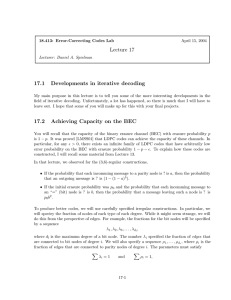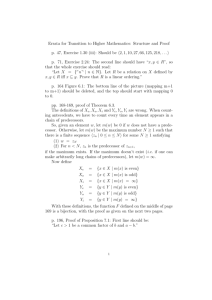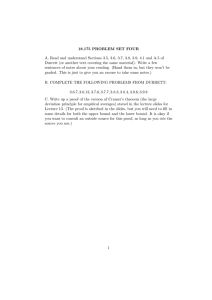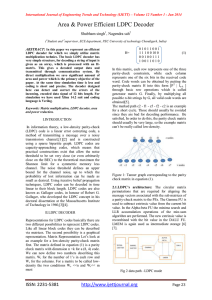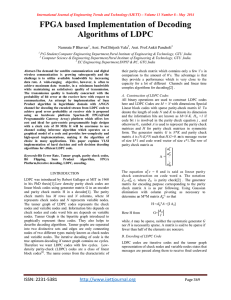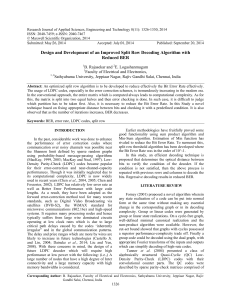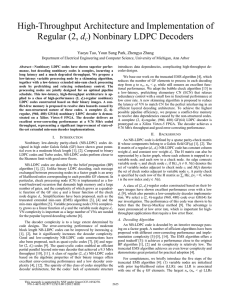Lecture 34: Iterative Message Passing Decoder
advertisement
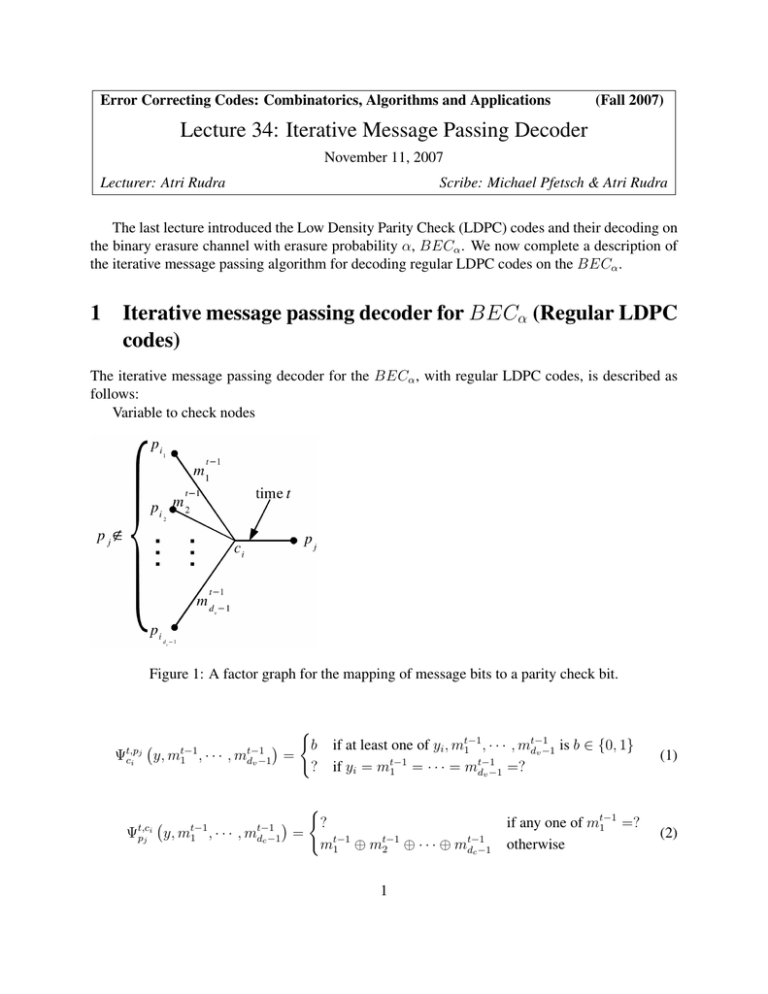
Error Correcting Codes: Combinatorics, Algorithms and Applications
(Fall 2007)
Lecture 34: Iterative Message Passing Decoder
November 11, 2007
Lecturer: Atri Rudra
Scribe: Michael Pfetsch & Atri Rudra
The last lecture introduced the Low Density Parity Check (LDPC) codes and their decoding on
the binary erasure channel with erasure probability α, BECα . We now complete a description of
the iterative message passing algorithm for decoding regular LDPC codes on the BECα .
1
Iterative message passing decoder for BECα (Regular LDPC
codes)
The iterative message passing decoder for the BECα , with regular LDPC codes, is described as
follows:
Variable to check nodes
Figure 1: A factor graph for the mapping of message bits to a parity check bit.
t−1
j
Ψt,p
y, mt−1
ci
1 , · · · , mdv −1
t−1
Ψpt,cj i y, mt−1
1 , · · · , mdc −1
(
b
=
?
t−1
if at least one of yi , mt−1
1 , · · · , mdv −1 is b ∈ {0, 1}
if yi = mt−1
= · · · = mt−1
1
dv −1 =?
(
?
=
mt−1
⊕ mt−1
⊕ · · · ⊕ mt−1
1
2
dc −1
1
if any one of mt−1
=?
1
otherwise
(1)
(2)
Figure 2: A factor graph for a regular LDPC code ((dv , dc ) ≥ 1).
Figure 3: A factor graph for the mapping of parity check bits to a message bit.
Claim 1.1. When a value in {0, 1} is sent as a message, it is correct. pj → ci ⇒ ith value = b
We now provide a sketch of the proof of this claim.
Proof. For the scope of this proof, let us temporarily define A to be the event that the correct value
was sent.
By induction, we conclude that at t = 0 (var→check), y ∈ {0, 1} ⇐⇒ A.
t−1
For t > 0 (check → var). By induction, mt−1
1 , · · · , mdc −1 are correct values.
t−1
t−1
By the parity check condition, ci ⊕ mi ⊕ ... ⊕ mdc = 0 (var→check) if y ∈ {0, 1} ⇒done.
By induction, any mt−1
∈ {0, 1} is a correct value (no “conflict”).
i
Remark 1.2. Messages are taken from the set {−1, 0, 1}, where a “1” is encoded as a “-1”, a
“0” is encoded as a “1”, and and erasure is encoded as a “0”. We can then make the following
2
conclusion:
j
Ψt,c
pi
=
dY
c −1
mt−1
i
(3)
i=1
We can now begin a discussion of the decoding algorithm.
2
Decoding algorithm
Let us define the variable l as a parameter. Run the following steps for l rounds:
Round l
Phase 1: ci sends message to pj using Ψcp,2l
(· · · ) (for l = 0, ci sends yi to pj )
i
ci ,2lt
Phase 2: pj sends message ci using Ψpj (·)
We now describe the paradigm proposed by R. G. Gallager, which can be divided into the
following three steps:
1. Step 1: Code construction: The code is constructed by picking an explicit graph of girth
g = Ω (log (n)) as a factor graph. (4l < g)
2. Step 2: Analysis of decoder: Given an edge, let sre be the probability that ein erasure is
passed over e at round r. It is now necessary to derive a recurrence relation between sr+1
e
and sre .
3. Step 3: Threshold computation: The threshold α∗ is computed (either analytically or experimentally) such that, for every α < α∗ , the probability of error, pe , approaches zero,
as ple → 0, for any e (If α > α∗ , then ple > 0). We conclude that one can have reliable
transmission over BECα for every α < α∗ .
We will not cover Step 1 at this time. We refer the reader to the book Low-Density Parity-Check
Codes, by R. G. Gallager [1], for further details of Step 1. The following three claims are made for
Step 2:
Claim 2.1. sre = sre0 , ∀e, e0
To prove this claim, we simply use sr , and the rest if the proof follows from induction.
Claim 2.2. Messages received by any node in round r ≤ l are all independent.
Claim 2.2 can be proved by the following proof by picture:
Proof. (by picture) Consider a check node pi . The “dependence” tree is unraveled up to round 0.
In Phase 1 of the decoding algorithm, the leaves of the tree are yi0 s.
Before making the final claim, note that every message depends on distinct yi0 s, each of which
are independent random variables by a property of the BECα .
3
Figure 4: Parity-check “dependence” tree
Claim 2.3. All of the leaves of the tree correspond to yi0 s for distinct i values.
This claim can be proved with the following proof by contradiction:
Proof. For the scope of this proof, let us temporarily define A as be the event that all of the leaves
of the tree do not correspond to yi0 s for distinct i values, and let us also temporarily define B as
the event that a cycle in the factor graph exists. The event B could occur if the leaves w and w0
corresponded to the same yi value (or variable node). We assume that A =⇒ B, and consider the
following cycle in the factor graph:
w ! pj ! w 0
{z
}
|
≤2l
Thus, there is a cycle in the factor graph of length ≤ 4l < g, and the event B is true, which is
a contradiction. We conclude that the final claim is true.
Thus, we can observe that the random variables, yi , which correspond to distinct messages, i,
in the tree, are independent random variables.
4
References
[1] R. G. Gallager. Low-Density Parity-Check Codes. M.I.T. Press, Cambridge, MA, 1963.
5

